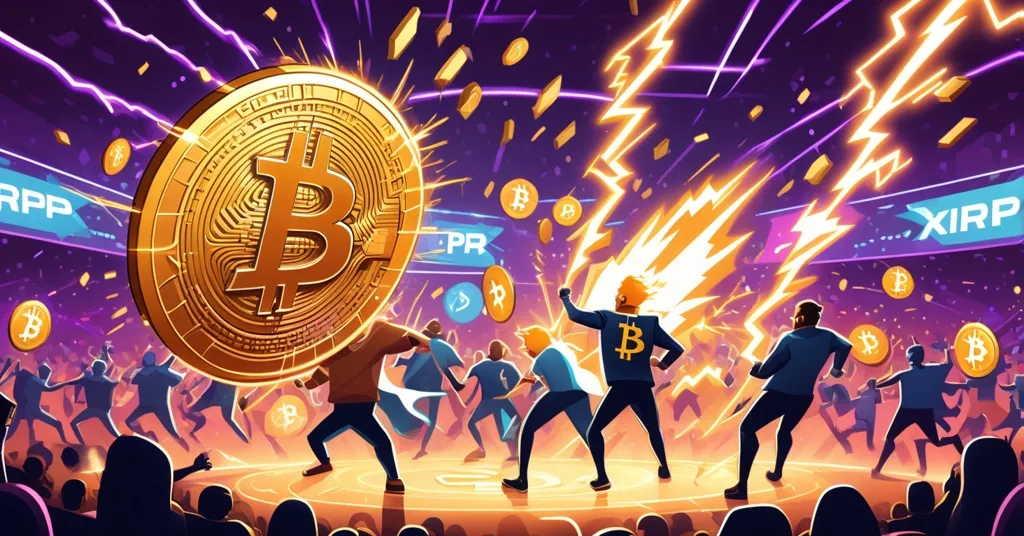Bitcoin’s X Account Mocks XRP with Brutal Meme, Sparks Fierce Crypto Feud

Bitcoin’s Official X Account Slams XRP with Meme, Reigniting a Brutal Crypto Showdown
Bitcoin and XRP are back in the ring, slugging it out over a meme that’s more savage than a 2017 bear market. On June 20, 2025, the official Bitcoin X account (@Bitcoin) dropped a digital bomb, posting an image of a child stepping in “crap” with XRP’s logo slapped on the mess. The jab didn’t just sting—it sparked a full-on war of memes and words between two of crypto’s most polarized communities.
- Trigger Point: Bitcoin X account mocks XRP with a derogatory meme on June 20, 2025.
- Community Firestorm: XRP fans retaliate with counter-memes and sharp critiques of Bitcoin’s tech.
- Underlying Rift: Highlights a decade-long clash over decentralization, speed, and crypto’s true purpose.
The Meme War Erupts: A Digital Slap in the Face
The meme from @Bitcoin wasn’t subtle. It portrayed XRP as literal rubbish underfoot, a visual gut-punch that spread like wildfire across X. Within hours, the XRP community hit back hard. User Six8Jay flipped the script with a counter-meme dubbing Bitcoin “slow crap,” a direct shot at BTC’s sluggish transaction confirmations, which can drag on for minutes or even hours during network congestion. The drama escalated as posts, insults, and hashtags piled up, turning a single image into a public brawl watched by thousands, with plenty of community reactions on platforms like Reddit.
Adding fuel to the fire, XRP YouTuber Alex Cobb revealed a personal slight—he’d been blocked by the Bitcoin account. “Super bearish,” he called it, framing the move as a sign of weakness rather than strength from the BTC camp. Meanwhile, XRP advocate Edoardo Farina, founder of Alpha Lions Academy, didn’t mince words in defending his coin’s honor.
“Bitcoin is the (B)eta (T)est (C)oin,” Farina snapped, arguing XRP was built to fix Bitcoin’s outdated, energy-guzzling proof-of-work system.
Another XRP supporter, known as RISKTAKE on X, offered a psychological take on the attack. “They only attack what they’re threatened by,” they posted, suggesting Bitcoin’s trolling masks insecurity about XRP’s potential to outshine it in key areas like scalability. For more on Farina’s perspective, check out his statements on Bitcoin’s flaws and XRP Ledger’s strengths.
Bitcoin vs. XRP: A Rivalry Rooted in Tech and Ideology
For those new to the crypto space, let’s break this down. Bitcoin (BTC), launched in 2009 by the elusive Satoshi Nakamoto, is the OG cryptocurrency. It runs on a proof-of-work (PoW) system, where miners act like locksmiths crafting unique keys to secure a digital vault—slow but damn near unbreakable. This makes Bitcoin a fortress of decentralization and a store of value, often likened to digital gold. But it’s not built for speed; transactions average 10 minutes per block, and energy use is a beast, with estimates suggesting BTC consumes more electricity than some mid-sized countries.
XRP, born in 2012 under Ripple Labs with architects like David Schwartz, Jed McCaleb, and Arthur Britto, takes a different road. It uses a consensus protocol on the XRP Ledger (XRPL), settling transactions in 3-5 seconds for pennies. Think of it as a multi-lane expressway for payments, tailored for real-world use like cross-border remittances. Critics, especially Bitcoin maximalists, slam XRP as too centralized due to Ripple’s influence and massive holdings—over 50% of XRP supply sits in escrow controlled by the company. To them, it’s a corporate token dressed in blockchain clothing, far from the cypherpunk rebellion Bitcoin embodies. For a deeper dive into these differences, see this detailed comparison of Bitcoin and XRP.
This isn’t just a tech debate; it’s a clash of visions. Bitcoin purists see their coin as the ultimate middle finger to centralized power—banks, governments, fiat. XRP backers argue for pragmatism, claiming speed and efficiency are non-negotiable for mass adoption, even if it means playing ball with institutions. Both have merits: Bitcoin’s hash rate, a measure of its network’s computational muscle, makes it a digital juggernaut nearly impossible to hack. XRP’s throughput, on the other hand, handles use cases BTC can’t touch without add-ons like the Lightning Network, which still struggles with scale and adoption hurdles. The centralization debate between Bitcoin and XRP remains a hot topic in these discussions.
Historical Baggage: From Reserves to Rejected Olive Branches
This meme spat isn’t a one-off. Tensions boiled over earlier in 2025 around a proposed U.S. crypto reserve initiative, a plan to stockpile digital assets as a national strategy. Bitcoin maximalists accused Ripple CEO Brad Garlinghouse of pushing XRP over BTC, a claim he shot down fast. Garlinghouse has been vocal about blockchain’s broader role in finance, recently speaking at the Apex 2025 conference in Singapore. There, he hailed Circle’s successful IPO and hyped upcoming U.S. stablecoin regulation via the GENIUS Act, signaling Ripple’s ambitions beyond XRP—think RLUSD, their own stablecoin play aimed at institutional trust and DeFi competition. Get the latest on this U.S. crypto reserve and stablecoin controversy.
Then there’s the “Skull of Satoshi,” an art piece donated by Ripple as a supposed peace offering. It nods to Bitcoin’s cultural weight while critiquing its energy footprint—a cheeky gesture meant to ease tensions. Instead, it got buried under this latest meme avalanche. Picture this: Ripple hands over a satirical olive branch, and Bitcoin’s response is to photoshop XRP as dog mess. If that doesn’t scream petty tribalism, nothing does. This ongoing feud was recently highlighted in a report on Bitcoin’s X account trolling XRP.
Who’s Behind the Bitcoin Account Anyway?
Here’s a wrinkle worth unpacking: who the hell runs @Bitcoin? Unlike Ripple, with its clear corporate structure, Bitcoin has no CEO, no headquarters—it’s decentralized to its core. The “official” X account could be managed by a community group, a die-hard maximalist with an axe to grind, or even some random meme lord with access. This murkiness adds a layer of absurdity to the drama. When an “official” handle throws punches, who’s accountable? It’s a stark reminder that decentralization, while empowering, can also breed chaos in public-facing narratives. For more specifics on this incident, see the full breakdown of the June 20 meme controversy.
Stablecoins and Shifting Battlegrounds
While memes dominate headlines, Ripple’s broader moves might quietly change the game. Stablecoins—digital assets pegged to stable values like the U.S. dollar—are exploding as a bridge between crypto and traditional finance. With RLUSD, Ripple is gunning for a slice of a market led by giants like Tether (USDT) and Circle (USDC). This pivot positions XRP less as a direct Bitcoin rival and more as a player in institutional and regulatory-friendly spaces BTC doesn’t touch. Could this reduce the heat of these rivalries over time? Possibly, but don’t hold your breath while X posts keep fanning the flames.
Broader Implications: Is Tribalism Crypto’s Achilles’ Heel?
Zooming out, this Bitcoin vs. XRP feud isn’t just a sideshow—it’s a symptom of a fragmented space. Social media spats might rack up retweets, but they risk painting crypto as a circus of squabbling kids, not a serious alternative to fiat. Newcomers peering in might think, “Why bother with this mess?” when we should be showing unity against the real enemy: centralized financial systems that choke freedom and privacy. And let’s be real—this childish X bickering makes the industry look like a bloody joke, hardly the revolutionary force we claim to be. The impact of tribalism on crypto adoption is a growing concern worth considering.
Both sides have blind spots. Bitcoin’s energy consumption is a PR disaster in a sustainability-obsessed world, with PoW drawing flak for burning through power like there’s no tomorrow. XRP’s centralization concerns aren’t baseless either—Ripple’s grip on supply and cozy ties with banks raise legit questions about whether it’s truly decentralized or just a wolf in sheep’s clothing. But are meme wars the way to hash this out? Hell no.
Playing Devil’s Advocate: Tough Love for Both Camps
As a Bitcoin maximalist at heart, I’ll always champion BTC as the bedrock of this financial uprising. Its unyielding focus on decentralization is the ultimate screw-you to the status quo—a pure, untouchable store of value. But let’s not pretend it’s flawless. Is Bitcoin’s stubborn refusal to compromise on PoW making it a relic in a world desperate for practical, scalable solutions? On the flip side, XRP’s corporate leanings might feel like a betrayal to cypherpunk ideals, but isn’t some level of institutional buy-in a necessary evil to drag blockchain into the mainstream? Altcoins and protocols like Ethereum fill niches Bitcoin shouldn’t even try to tackle, and that diversity strengthens the ecosystem. Can we admit that without biting each other’s heads off? For insights into why Bitcoin and XRP communities often clash, the debate continues across various platforms.
Key Takeaways and Burning Questions
- What sparked this latest Bitcoin-XRP showdown?
A meme posted by the Bitcoin X account on June 20, 2025, likening XRP to “crap” under a shoe, which unleashed a storm of retaliation from XRP supporters with counter-memes and tech critiques. - Why do Bitcoin and XRP communities keep clashing?
It’s a battle of philosophies—Bitcoin stands for pure decentralization and security, while XRP prioritizes speed and utility, leading to accusations of obsolescence or betrayal on both ends. - Does this petty drama damage crypto’s bigger mission?
Damn right it does; divisive spats alienate potential adopters and make the space look immature when the focus should be on dismantling traditional finance together. - Could Ripple’s stablecoin push like RLUSD shift the rivalry?
It’s possible—by targeting institutional and regulatory-friendly markets with stablecoins, XRP might carve a lane Bitcoin doesn’t compete in, potentially cooling direct conflict over time. - Who gains from this tribal nonsense in the long run?
No one; short-term engagement spikes aside, it distracts from shared goals like financial freedom and decentralization, handing ammo to skeptics and regulators while banks laugh on the sidelines.
If crypto is truly about liberation, isn’t it time we freed ourselves from this toxic tribalism? I’m all for effective accelerationism—pushing hard and fast to disrupt the financial old guard—but that means building, not bickering. Bitcoin remains the heart of this revolution, a defiant stand against control. Yet XRP and other innovations have their place, solving problems BTC isn’t meant to. So, let’s cut the crap, literal and figurative. The real fight isn’t on X; it’s against a system counting on us to implode. Prove them wrong. Build bridges, not burn them.



